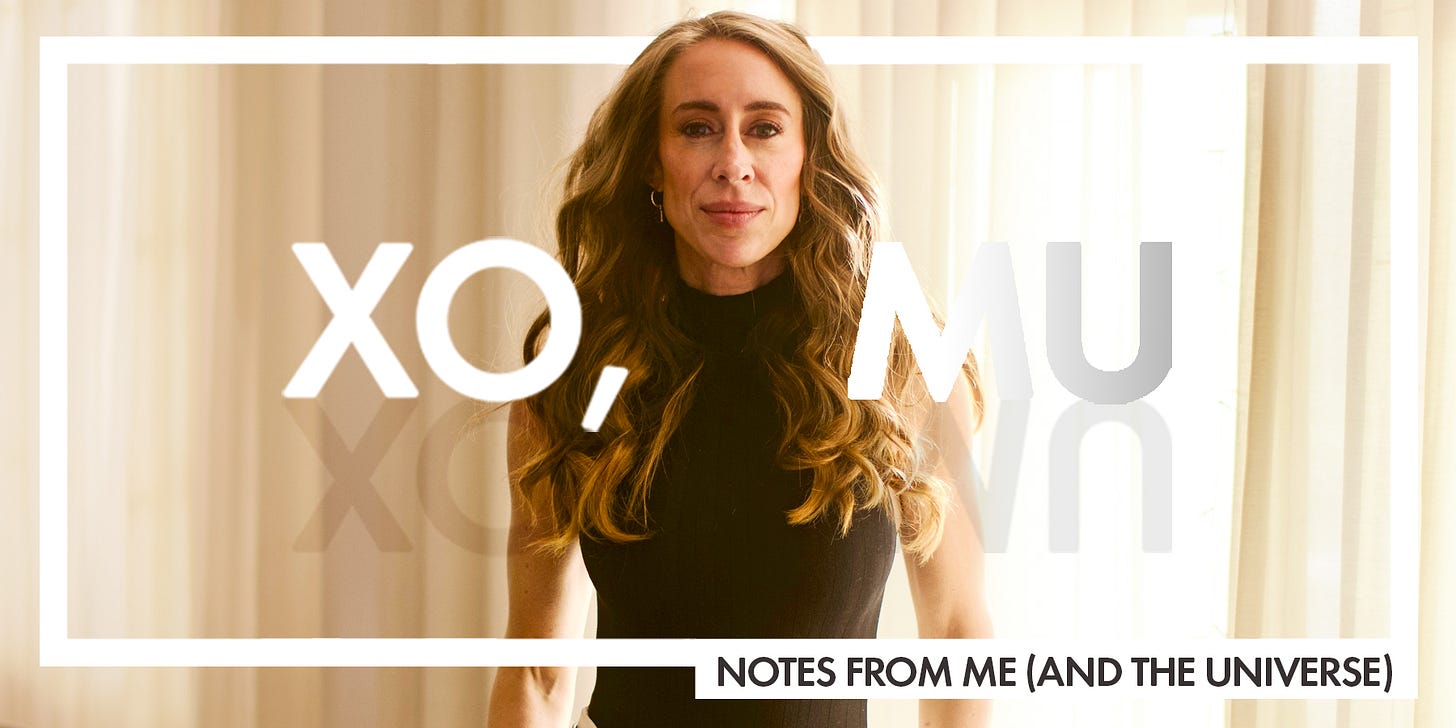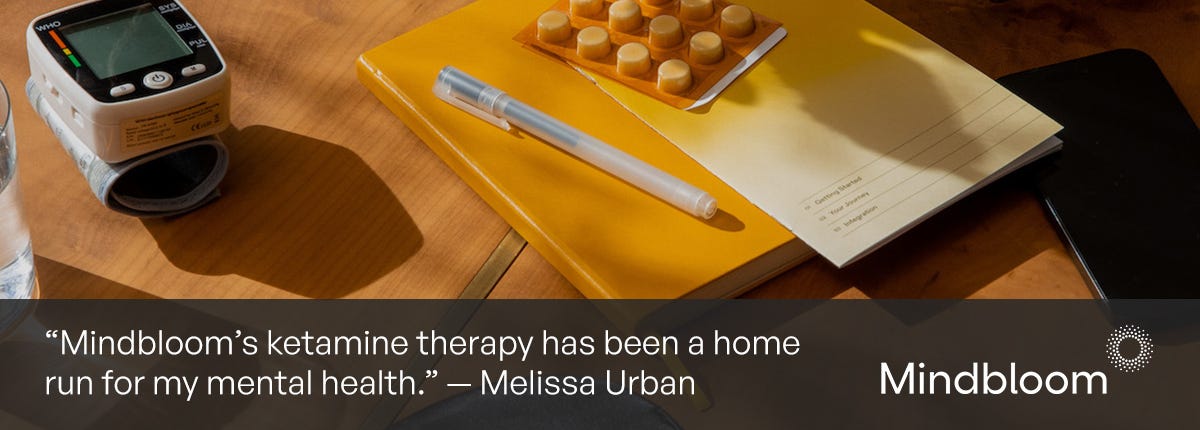Ketamine therapy for my mental health, part 3
What an at-home ketamine treatment session looks like for me
This post contains affiliate links for Mindbloom. That means I make a commission when you sign up through my link. My first 24 ketamine treatments were paid for with my own money. I spent a full year testing their program before writing about it, because I take my endorsements and your trust seriously. XO
I first began ketamine therapy for mental health in December 2019, using injections administered at a local medical clinic. In November 2023, I transitioned into at-home treatments with Mindbloom. My Mindbloom sessions (supervised by a psychiatric clinician and integration guide) have been even more effective, and provided a far more pleasant, comfortable, and convenient experience. I am currently in maintenance mode with the therapy, consisting of weekly treatments for 5-6 weeks, followed by a several-month break. (You can read about my first 15 months on Mindbloom here.)
Many of you have asked follow-up questions about my Mindbloom experience. The most commonly asked question is, “What does a typical session look and feel like?” Today I’ll walk you through one of my treatments.
Note: Before my first session, my guide had me check my pulse and blood pressure on a video call, and led me and Brandon through an orientation. She also met with me immediately following my session. After that, my sessions looked largely like this.
Timing
I plan my treatments for Friday, Saturday, or Sunday around 3 or 4 PM. The weekends already feel relaxing, and I’m always hungry after a session. This allows me to have an hour for my treatment, take my time integrating and journaling, then eat dinner and get to bed early. My Mindbloom sessions also help me sleep well, which is why late afternoon is the sweet spot.
Planning and preparation
I start thinking about the session around noon. I want to eat a meal about three hours prior, so I’m heading into a treatment with a mostly empty stomach. (I’ve never once been nauseous during a treatment, but it can happen. Your Mindbloom clinician can prescribe anti-nausea medicine just in case.) I also want to be hydrated, but not so hydrated that I have to get up and use the bathroom mid-treatment.
A half-hour prior, I’m starting to relax and preparing my space. Set and setting are everything when it comes to psychedelic medicine. I find a comfortable, quiet space, usually in my living room or bedroom. I like looking at the trees outside during treatments, so I’ll make sure the curtains are open, but the sun isn’t blinding me. (Mindbloom provides you with an eye mask, but I prefer not to use it.) I’ll wear cozy sweats, cashmere socks, and have a few fluffy blankets handy. I bring the medication, an empty glass (to dispose of the medication), and a full water bottle into my treatment space.
I also spend some time preparing in the Mindbloom app. I’ll first set my intention for the session; today my general intention is “connection.” Mindbloom then offers journal prompts to help me dive deeper. After answering a few questions, it suggested three intentions for my session, all based on connection. You can either select one of theirs, or write your own intention.
Finally, I choose an audio track from the Mindbloom app—they have a ton of options, from spoken word to nature sounds and instrumentals. You don’t have to use one of their tracks (I occasionally use a ketamine playlist on Spotify), but their library and filters are extensive, and I can usually find just the vibe I’m looking for. I’ll download the audio track during my prep so I don’t get any interruptions during the session itself. I also place my phone in airplane mode before I begin.
Peer Treatment Monitor (PTM): You’ll never do a Mindbloom session alone. A PTM is a trusted individual (a partner, family member, or close friend) who supports you during your sessions by maintaining a safe and focused environment. Their presence is required to monitor your health and assist you during your sessions.
Brandon is my PTM, so when I’m ready to start, I’ll let him know I’m beginning, and where I’ll be. He mutes the doorbell, answers the door, keeps the dogs from barging in, and checks on me often. (So as not to disturb my experience, he’ll quietly inquire how I’m doing, and I’ll give him a thumbs-up.)
The treatment
Treatments last about an hour, start to finish. To begin, I place the tablets between my cheek and gums. They tingle a little but don’t taste bad, and they dissolve quickly. The tricky part is holding the tablets and your saliva in your mouth without swallowing for 7 minutes. During my first session, this felt uncomfortable, but I don’t even think about it now.
Caution: You really don’t want to swallow the medicine. It won’t improve your session or learnings, but it can leave you nauseous, brain foggy, and out of it for many hours.
In the beginning, it helped to sit up and tilt my chin slightly down while holding the medicine in my cheeks, to minimize the urge to swallow. I listen to my Mindbloom track until a gentle gong or chime notifies me of the 7-minute mark. Then, I spit the tablet remnants and saliva out, swish with water, and spit that out too. (Sometimes, it’s bright pink!) After my mouth feels rinsed, I’ll drink a sip or two of water, then lie back. It’s normal for your gums to be slightly numb where you placed the tablets; it fades quickly.
The session itself—we’ll call it the journey—lasts about an hour, and here is where I need to make a stark comparison. During my in-clinic injections, I tripped my balls off, no joke. I always wondered if I had died. I was completely disassociated from my body, and I couldn’t so much as twitch my finger. I hallucinated, time distorted terribly, and if I wasn’t so experienced with acid, I might have freaked out the first time. Also, I was so out of it that I had zero revelations or useful thoughts during the session itself—there was nothing to integrate. I hated the experience, and the severe nausea and brain fog that followed me for hours afterwards—although it did put my depression at bay for a few months at a time.
My Mindbloom journey offers a night and day difference. First, it’s incredibly pleasant. I feel a little floaty, like when you’re falling asleep into a lovely dream. My brain wanders, and I may get flashes of thoughts or memories, but at no point do I feel like I’m straight-up hallucinating. Time does seem to slow down, but it’s not disconcerting. I often feel like I’m falling into the audio track in a powerful way—not the “is the devil speaking to me through Spotify” I used to get during injections. With Mindblom, I experience a mild disassociation from my body, which feels light and airy and not at all scary. I’m always free to move or adjust my position as I choose. (As I’ve explained to Brandon, if I had to get up in an emergency, I could.)
I’m also able to string coherent thoughts together, which means I’m able to focus on my intention. Ketamine feels like it’s making connections in my brain that I might never arrive at otherwise, and I’m present enough in those thoughts to remember them. These revelations happen reliably in my Mindbloom sessions, which means I actually have tangible experiences to integrate. Some of my most powerful learnings happened inside a Mindbloom journey!
After about 45 minutes, I can feel the medicine starting to wear off. Things come more into focus, I return into my body, and I start to prepare myself to end the session. (It’s like wiggling your toes and fingers in Shavasana.) When I’m ready, I’ll sit up, stop the audio track, sip on some water, call to Brandon that I’m done and feeling good, and start to journal.
After the session
For the next 30 to 60 minutes, I’ll try to maintain this peaceful environment and do things that help me relax and reflect. Mindbloom provides several ways to journal your reflections, including a book and pen and a dedicated spot with prompts in the app. I might also start meal prep (chopping vegetables is relaxing for me), sit with Brandon and talk about my experience, or take the dogs for a short walk.
Integration: The act of sharing, exploring, and processing the wisdom, insights, or questions that come up during and after a session. Mindbloom says, “During your Mindbloom integration, you are taking disparate insights—or parts of yourself that you may or may not have been aware of—and intentionally bringing them into yourself, to facilitate personal healing.”
Mindbloom offers a few ways to integrate your sessions. There are plenty of self-guided resources, but you can also join a group integration circle. I’m not much for groups, but meeting with others on the same journey can help you feel less alone, and reassure you that what you’re feeling and experiencing is normal. I prefer the one-on-one integration sessions with my guide. I’ve had astonishing breakthroughs talking with my guide, some of which felt game-changing in terms of my depression. Guides are always available to you, and Mindbloom will also prompt you to schedule sessions to stay on track with your clinician-prescribed protocol.
The other thing I learned with Mindbloom (that my injection clinic never mentioned) were the benefits of psychedelic therapy in the days following a treatment. After my first session, my guide explained that the medicine can have neuroplastic benefits that extend for a few days after your treatment. (A leading theory proposes that ketamine stimulates regrowth of synapses—connections between neurons)--effectively rewiring the brain.) She recommended I spend extra time integrating during those first few days.
Because of this, I spend extra time meditating in the days following a session, keeping my intention at the front of my mind. I’ve been surprised at the insights I’ve gained here, too! It feels like my Mindbloom treatments keep providing benefits long after I’ve stopped feeling the medicine’s effects—something that never happened with injections.
With injections, it felt like the medicine was doing all the work. It brute-forced rebooted my brain into a new pattern, which did make me feel better for a while, but didn’t leave me with any new insights or tools. With Mindbloom, I feel like the medicine helps me shift my brain such that I’m able to do the work. (In fact, that was one of my first insights after a journey!) I feel more empowered, more confident, and more partnered with the medicine, and as a result, my Mindbloom sessions have been far more effective long-term.
I’ll just keep saying it—Mindbloom has been the best thing I’ve ever done for my mental health, and literally everyone in my life has noticed the difference. (It’s done wonders for my relationship.) Click here to see if you’re a good candidate for Mindbloom therapy.
XO, MU





I really wish microdosing/psychedelics were legal here...........
All of the ketamine info that you have shared has been so helpful. It looks like mindbloom also has an injectable option now. Have you only done lozenges? Would you consider doing the injectables, if you haven’t already?